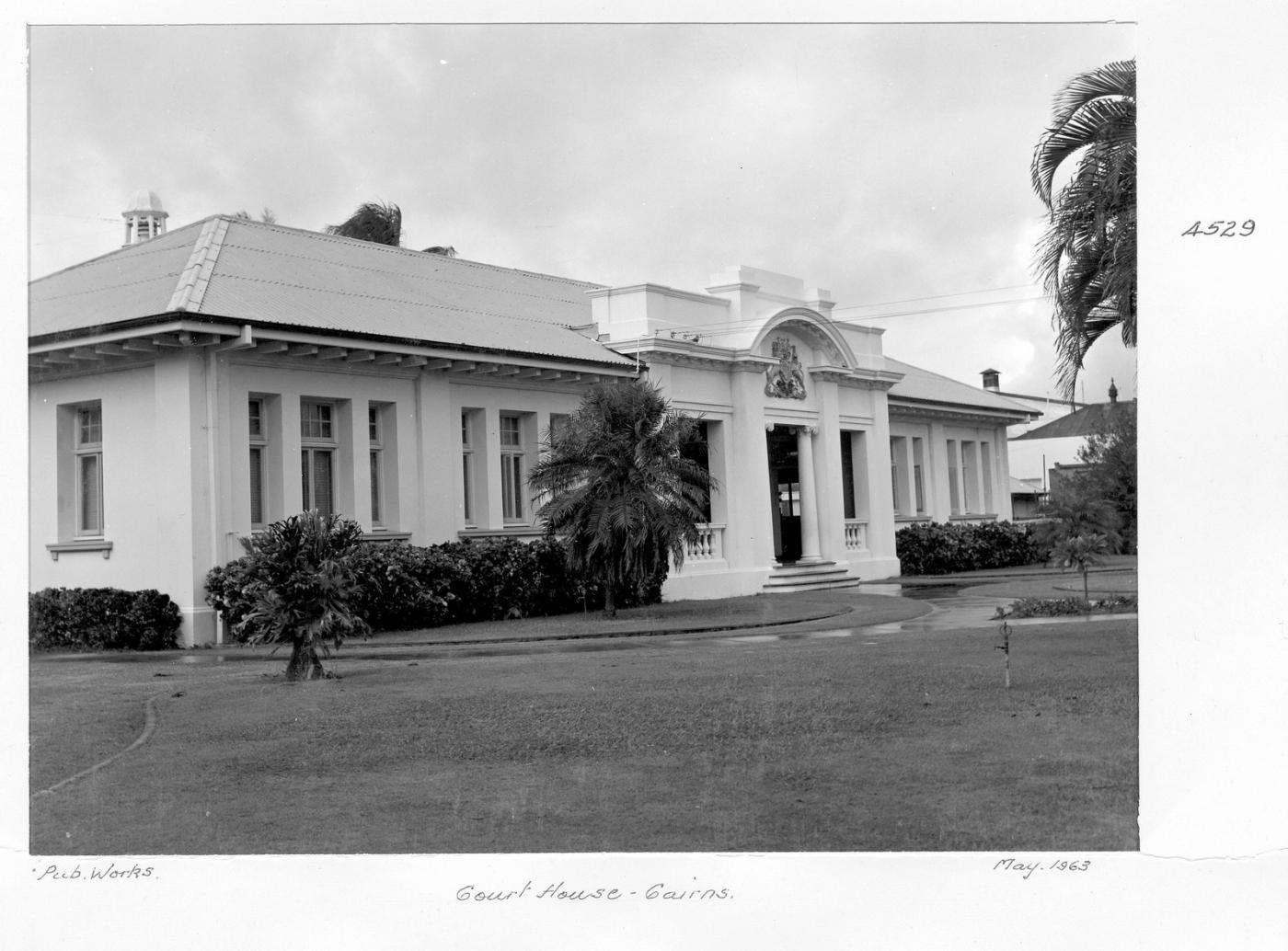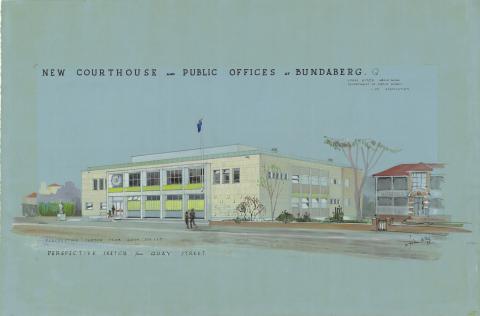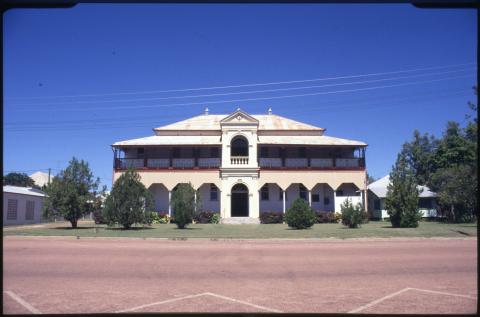
- News of the day
-
Cairns Post, Thursday 5 July 1923, page 4
Defects of the Court House.
Although the Cairns Court House is a most imposing structure, the acoustic properties have proved a failure since its opening, a difficulty which has riot yet been overcome. Another little oversight, which though easily overcome, would be a great consideration to counsel and others connected with Court work was the matter of the absence of blinds on the windows, the afternoon sun streaming on to both judge's and counsel's table being most disconcerting.
- Background
-
The former Cairns Court House [erected 1919-21] and the Art Gallery former Public Offices [erected 1934-36] are located on a 2 acre site reserved since 1876 for police purposes. Both buildings were erected during the years between the First and Second World Wars, the third major phase of Cairns' development, at which time the city's status as the principal port of Far North Queensland was consolidated, and the city centre virtually re-built. Both are substantial masonry buildings, whose construction reflected State Government confidence in the growth of Cairns as an important regional centre during the interwar period.
Cairns was established officially in October 1876, as a port to service the newly discovered Hodgkinson goldfields. In this first phase of Cairns' development there was a small flurry of building activity [mostly shanties and tent houses], but the town competed with both Cooktown and Port Douglas for the Hodgkinson trade, and made little progress until the establishment of a local sugar industry and the opening up of the Atherton Tablelands' mineral fields, in the early 1880s. The 1885 announcement that Cairns was to be the terminus for the Herberton railway established the town as the principal port in the region. These boosts to the local economy in the 1880s generated a second building and development phase, during which the early temporary structures were replaced by more substantial timber buildings.
Whilst a number of masonry commercial buildings were erected in Cairns in the years immediately preceding the First World War, the third major phase of Cairns' development was during the 1920s and 1930s. The Cairns hinterland Soldier Settlement Schemes of the 1920s, the completion of the rail link to Brisbane in 1924, the extensive re-building necessitated by a spate of cyclones in the 1920s, and the poor condition of earlier timber structures, combined to produce unprecedented building activity in Cairns. The city centre in particular is dominated by masonry structures of the 1920s and 1930s, and in this respect is markedly different from other Queensland towns and cites. Reinforced concrete was the preferred building material, but the State Government chose to erect the important Public Offices in brick.
Court House
The 1919-21 building was the third court house erected in Cairns. An 1878 marine survey of Cairns harbour indicates that the first court house was located on the customs reserve, and may have shared the same premises as the first customs house. This probably was the temporary court house erected by the Works Department in Cairns in December 1877.
The 'temporary' courthouse remained in use for several years, but was replaced during the second phase of Cairns' development. In 1883 the Works Department prepared plans for a more substantial timber court house, which was erected in 1884 on the Esplanade, but facing Abbott Street, on the police reserve. At the time, it was considered to be very fine, the best erected building in Cairns, both in so far as appearance and design as well as in construction [Cairns Post 3 July1884:2:4]. By 1890, however, the local court had outgrown its court house, and the building was in a state of disrepair. Despite repeated comment from public and judicial circles alike that the court house at Cairns was the worst on the circuit, it was not replaced until the present building was completed late in 1921.
In 1917, AB Brady, Government Architect and Under Secretary for Public Works, finally acknowledged that the Cairns Court House was beyond renovation and that a new building was necessary. Plans were prepared in the government architect's office in 1918, working drawings were completed by January 1919, tenders for the supply of materials were called early in 1919, and construction was commenced in May that year. As a post-First World War initiative by the state government to create employment for returned servicemen, the new court house at Cairns was constructed using day labour, under the supervision of the District Foreman of Works, EJ Oakley. The construction period stretched over two and a half years, with the Cairns community attributing the slow progress of the building to the use of day labour.
Some of the joinery was made in government workshops in Brisbane and shipped to Cairns, but the remainder of the timber used in the construction was secured from the Cairns hinterland. Particularly impressive were the silky oak fittings in the court room. The roof was of fibrous-cement tiles with terracotta ridge capping. This roof was replaced with corrugated fibrous-cement roof sheeting in 1953, at which time the roof ventilators were removed.
By November 1921 the new court house, which had cost over £13,500, was completed, and the court room was used for the first time on 17 January 1922. From this first sitting, it was evident that although the room was well ventilated, the acoustics were poor due to the height of the ceiling. Not until 1959 was the problem rectified, with a false acoustic ceiling fixed to the existing beams.
In 1926, the city's sesqui-centenary year, the Cairns Chamber of Commerce requested that the State Government improve the Court House grounds. In January 1927, the Cairns City Council agreed that their gardener at Edge Hill would lay out the grounds, to include concrete kerbing around the oval in the centre, and garden tile edging. Government approval for funding the project was granted in January 1928, and the gardens were completed by early 1929. Concrete paths were laid in the grounds in 1946, and in 1949/50 the grounds were replanted.
In 1968, the building was extended at a cost of approximately $53,000, with the extentions rendered to match the existing facades, and the roof re-clad with corrugated iron sheeting. The remodelling created a second court room and a magistrate's court.
Former Public Offices [Art Gallery]
In 1929, the State Government Insurance Office [SGIO] requested that part of the Police Reserve at the corner of Shields and Abbott Streets, Cairns, be made available for the erection of a new SGIO office. In 1930, the Government Tourist Bureau submitted an identical request. In February 1933, the Public Service Commissioner reported on the requirements for an office building on the site, which would necessitate the re-location of the Senior Sergeant's Residence and the Tracker's Hut. In the same month, Cabinet approved that the Works Department erect an office building for and at the expense of the SGIO, and sketch plans were completed in April that year. By September 1933, however, the Public Service Commissioner had decided that the government would erected the building with general funding, and rent offices to various government departments.
Construction commenced in 1934, with the plans attributed to architect RC Nowland of the government architect's office. The new building was constructed mainly of hinterland materials, with bricks from Mareeba and joinery from Johnston's Stratford Sawmill. The principal offices and public spaces were wall-panelled and floored with local figured timbers as a promotion for North Queensland timber products. However, the leadlights were supplied by a Brisbane company, and the roof was clad originally with fibrous cement tiles supplied by Hardie & Co.
The new Public Offices occupied a prominent position at the intersection of Abbott and Shields Streets, which contained Cairns' conspicuous First World War memorial (QHR 600378). The building was designed to address both the adjacent court house and the newly established formal court house gardens, and the classical detailing of the facades re-affirmed the power and presence of government in the community. The building also was designed to be extended along Shields Street, with a repeat of the portico on the western end, but this planned extension was never undertaken.
The new Public Offices were completed by late March, 1936, and were opened officially in July that year. They had cost nearly £31,000. The principal ground floor tenant was the SGIO, with the Government Tourist Bureau occupying an office with display windows at the front. Other ground floor tenants included the Land Commission, Agricultural Bank, and Forestry officers. The principal occupant of the first floor was the Public Curator, along with the District Foreman of Works, Inspectors of Weights and Measures, Health, Slaughter Houses, Fruits and Diseases in Plants, and visiting Tax Inspectors and parliamentarians.
Late in 1936, the grounds around the new Public Offices were laid out, with concrete kerbing to match that in the court house gardens, and the lawn extended to the new building.
In the mid-1950s the Government Tourist Bureau and the Department of Agriculture and Stock vacated the building, and the Works Department re-located some offices there in 1957. The SGIO vacated the building in 1969, following which the Public Curator's Office moved to the ground floor, and the Valuer General's Office occupied the whole of the first floor. In mid-1980, the Public Curator's Office vacated the building, following which the interior was remodelled, and the ground floor occupied principally by offices of the Magistrate's Courts. In 1992/93 the building was converted for use as the Cairns City Council's Fine Arts Gallery.Courtesy of the Queensland Heritage Register.
/145.7771187,-16.921493,7/450x450@2x.png?access_token=pk.eyJ1IjoicXNhLWRpc2NvLXFsZCIsImEiOiJjamJmdTgyZXEyeWNjMnlxZm8xcmtieHgxIn0.lmT9J5tTPKGuuccQgCVSAg)



